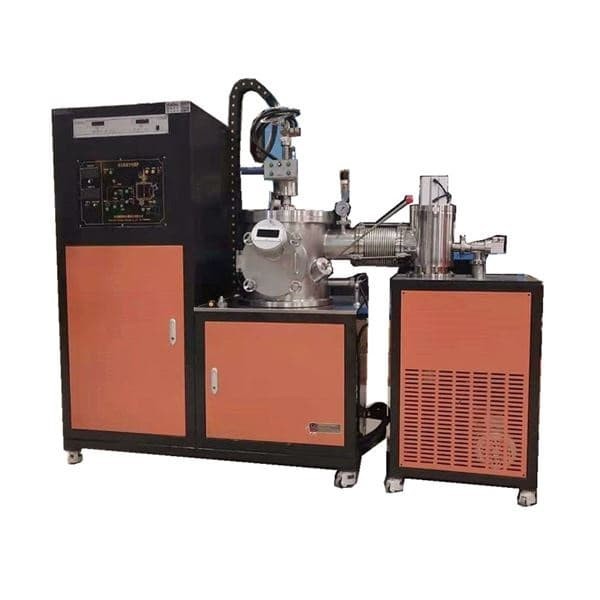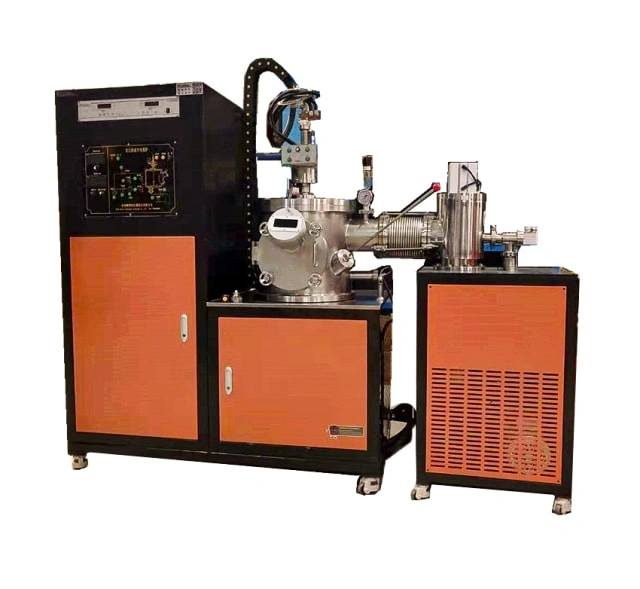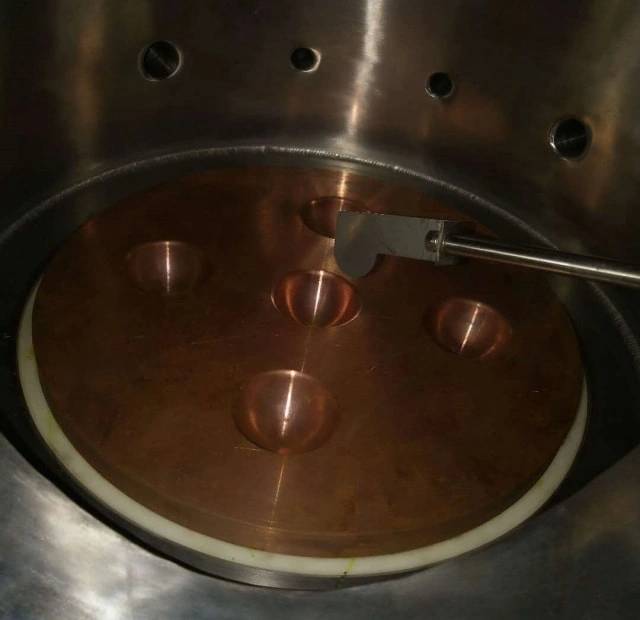
真空炉
真空电弧感应熔炼炉
货号 : KT-VA
价格根据 规格和定制情况变动
- 容量
- 1-200 公斤
- 工作电压
- 20-40 伏特
- 真空压力
- 1.3-1.3x10-2
运输:
联系我们 获取运输详情 享受 准时发货保证.
为什么选择我们
可靠的合作伙伴简易的订购流程、优质的产品和专业的支持,助力您的业务成功。
应用
真空电弧炉主要用于熔炼钛、铌、锆等活性金属以及钨、钼等难熔金属。此外,它还用于熔炼铁基、镍基、钴基等合金材料。
真空电弧炉的特点是高温、快速熔炼、显著的脱气效果、熔融金属无难熔物污染,并能减少金属中的非金属夹杂物。
真空电弧炉广泛应用于学校、研究所和机构中超高温金属材料、高熵合金材料、母合金材料、难熔金属材料、稀贵金属材料的冶炼和提纯。它可以有效地去除氧和杂质。
详情与部件


特点
- 炉体均为不锈钢材质,外观美观,不生锈。
- 采用立式圆筒形真空室
- 配有大直径观察窗,可实时观察炉内熔炼情况
- 熔炼温度高,温度可达3500度以上,
- 采用专用的电弧熔炼电源。
- 配有操作模拟屏,控制数据直观显示,操作直观简单
- 高真空设计,真空度可达5x10E-4Pa及以上
- 设有超温保护,并加装滤光玻璃保护眼睛
- 水冷铜电极可360度移动,操作灵活。同时,水冷坩埚体积小且可更换,可定制。
- 配有材料翻转装置,克服了材料单面熔化不均匀的情况
- 带真空吸铸的铸造站
- 设备效率:大多数金属材料加热重熔时间在一分钟或更短。
技术规格
| 型号 | KT-VA1 | KT-VA5 | KT-VA25 | KT-VA200 |
| 容量 (Kg) | 1 | 5-15 | 25 | 200 |
| 工作电压 (V) | 20-40 | |||
| 工作电流 (A) | 1000A | 3000A | 6000A | 12000A |
| 真空压力 (Pa) | 1.3-1.3x10-2 | |||
| 电极尺寸 (mm) | Φ25-40 x 400 | Φ10-45x1200 | Φ30-60x1350 | Φ56-150x1745 |
| 锭子尺寸 (mm) | Φ60x100 | Φ80x135 | Φ100x400mm | Φ200x670mm |
| 尺寸 (m) | 0.8x0.35x1.8 | 3.81x3.0x5.21 | 4.43x3.33x4.93 | 7.4x3.4x6.72 |
警告
操作员安全是最重要的问题! 请小心操作设备。 使用易燃易爆或有毒气体是非常危险的,操作人员在启动设备之前必须采取所有必要的预防措施。 反应器或室内正压工作是危险的,操作人员必须严格遵守安全规程。 使用空气反应材料时,尤其是在真空下,也必须格外小心。 泄漏会将空气吸入设备并导致发生剧烈反应。
为您而设计
KinTek为全球客户提供深度定制服务和设备,我们专业的团队和经验丰富的工程师有能力承担定制硬件和软件设备的需求,并帮助我们的客户 打造专属个性化设备和解决方案!
请将您的想法告诉我们,我们的工程师已经为您准备好了!
FAQ
什么是真空感应炉及其工作原理?
真空炉有哪些用途?
什么是 CVD 炉?
化学气相沉积(CVD)是一种利用加热、等离子体激发或光辐射等各种能源,使气态或气态化学物质在气相或气固界面上发生化学反应,从而在反应器中形成固态沉积物的技术。简单地说,就是将两种或两种以上的气态原料引入反应室,然后相互反应形成新的材料,并沉积在基片表面。
CVD炉是由高温管式炉单元、气体控制单元和真空单元组成的组合炉系统,广泛应用于复合材料制备、微电子工艺、半导体光电、太阳能利用、光纤通信、超导技术、防护涂层等领域的实验和生产。
真空感应炉的主要应用有哪些?
真空感应熔炼炉如何工作?
什么是真空电弧熔炼工艺?
真空炉的工艺流程是什么?
CVD 炉是如何工作的?
CVD炉系统由高温管式炉单元、反应气源精确控制单元、真空泵站和相应的组装部件组成。
真空泵用于排除反应管内的空气,确保反应管内没有多余的气体,然后管式炉将反应管加热到目标温度,反应气源精确控制单元可将不同的气体以设定的比例引入炉管内进行化学反应,在CVD炉内形成化学气相沉积。
使用真空感应炉有哪些优势?
真空感应熔炼有哪些优势?
什么是真空电弧重熔 (VAR) 炉?
真空炉中使用什么气体?
在 CVD 过程中使用哪种气体?
CVD过程中可以使用的气源非常多,常见的CVD化学反应包括热解、光解、还原、氧化、氧化还原,因此这些化学反应中涉及的气体都可以用于CVD过程。
我们以CVD石墨烯生长为例,CVD过程中使用的气体有CH4、H2、O2和N2。
真空感应炉可加工哪些类型的材料?
真空对感应熔炼炉有何帮助?
真空电弧熔炼炉如何工作?
真空炉中使用的加热元件是什么?
CVD 系统的优势是什么?
- 可根据需要制备金属膜、非金属膜和多组分合金膜等多种薄膜。同时,它还能制备出其他方法难以获得的高质量晶体,如 GaN、BP 等。可同时沉积大量成分均匀的涂层,这是液相外延(LPE)和分子束外延(MBE)等其他制膜方法所无法比拟的。
- 工作条件在常压或低真空条件下进行,因此涂层衍射效果好,形状复杂的工件也能得到均匀的涂层,这一点比 PVD 优越得多。
- 由于反应气体、反应产物和基材之间的相互扩散,可获得附着力良好的涂层,这对于制备耐磨膜和防腐蚀膜等表面强化膜至关重要。
- 有些薄膜的生长温度远低于薄膜材料的熔点。
- 有些薄膜的生长温度远低于薄膜材料的熔点,在低温生长条件下,反应气体和反应器壁及其所含杂质几乎不发生反应,因此可以获得纯度高、结晶度好的薄膜。
- 化学气相沉积可以获得光滑的沉积表面。这是因为与 LPE 相比,化学气相沉积(CVD)是在高饱和度下进行的,成核率高,成核密度大,且在整个平面上分布均匀,因此能获得宏观光滑的表面。
- 低辐射损伤,这是制造金属氧化物半导体(MOS)和其他器件的必要条件
真空感应炉中的真空环境如何改善材料性能?
什么是真空感应熔炼炉?
真空电弧熔炼炉有哪些应用?
PECVD 代表什么?
等离子体化学气相沉积(PECVD)是利用等离子体激活反应气体,促进基片表面或近表面空间发生化学反应,生成固体薄膜的技术。等离子体化学气相沉积技术的基本原理是,在射频或直流电场的作用下,源气体电离形成等离子体,以低温等离子体为能源,引入适量的反应气体,利用等离子体放电激活反应气体,实现化学气相沉积。
根据等离子体的产生方式,可分为射频等离子体、直流等离子体和微波等离子体 CVD 等......
PECVD 是什么意思?
使用真空电弧熔炼炉有哪些优势?
CVD 和 PECVD 的区别是什么?
PECVD与传统CVD技术的区别在于等离子体中含有大量高能电子,可以提供化学气相沉积过程中所需的活化能,从而改变了反应体系的供能方式。由于等离子体中的电子温度高达 10000K,电子与气体分子之间的碰撞可促进反应气体分子的化学键断裂和重组,从而生成更多的活性化学基团,而整个反应体系则保持较低的温度。
因此,与 CVD 工艺相比,PECVD 可以在较低的温度下进行相同的化学气相沉积过程。
使用真空电弧熔炼炉时应遵守哪些安全预防措施?
4.8
out of
5
Vacuum arc furnace is a great tool for melting active metals and preparing bulk amorphous materials by vacuum suction casting.
4.9
out of
5
The vacuum induction furnace allows for the smelting of refractory metals and the production of special corrosion-resistant and heat-resistant alloys.
4.7
out of
5
Vacuum induction melting furnace has the advantages of no air and vacuum induction furnace slag pollution, pure alloy, and low gas content.
4.8
out of
5
The vacuum induction furnace is widely used in the smelting and purification of various metal materials in schools, research institutes, and institutions.
4.9
out of
5
Vacuum arc furnace is characterized by high temperature, high speed melting, remarkable degassing effect, and free of refractory contamination of molten metal.
4.7
out of
5
The vacuum induction melting furnace is mainly composed of a furnace shell, inductor, crucible, furnace tilting mechanism, mold mechanism, power supply device, and a water cooling system.
4.8
out of
5
The vacuum arc furnace is mainly used to melt active metals such as titanium, niobium, zirconium and refractory metals such as tungsten and molybdenum.
4.9
out of
5
Vacuum induction melting technology and induction smelting technology have been applied in different occasions.
4.7
out of
5
The development and progress of vacuum induction furnace are mainly reflected in the gradual improvement of the overall structure of the equipment, the increasingly obvious trend of modularization and the more intelligent control system.
4.8
out of
5
Vacuum arc furnace is suitable for scientific research and small batch preparation of new vacuum metallurgy materials in universities and scientific research institutes.
4.9
out of
5
The vacuum induction furnace is widely used in the smelting and purification of ultra-high temperature metal materials, high entropy alloy materials, parent alloy materials, refractory metal materials, rare and precious metal materials.
4.7
out of
5
The vacuum arc furnace can effectively remove oxygen and impurities.
4.8
out of
5
The vacuum induction furnace is mainly used to melt active metals, such as titanium alloy, etc.
4.9
out of
5
The vacuum induction furnace can prevent melting of metals and alloys, and react with non-metallic inclusions.
4.7
out of
5
The vacuum induction furnace can remove the harmful dissolved gases and pollutants in molten metals.
4.8
out of
5
The vacuum induction furnace has the advantages of no air and vacuum induction furnace slag pollution, pure alloy, and low gas content.
4.9
out of
5
The vacuum arc furnace is widely used in the smelting and purification of various metal materials in schools, research institutes, and institutions.
4.7
out of
5
The vacuum induction melting furnace is mainly composed of a furnace shell, inductor, crucible, furnace tilting mechanism, mold mechanism, power supply device, and a water cooling system.
获取报价
我们的专业团队将在一个工作日内回复您。请随时与我们联系!
相关产品
相关文章

热等静压技术在镍基铸造高温合金中的应用
探讨如何利用热等静压提高航空航天应用中镍基铸造高温合金的性能。

真空感应熔炼炉:原理、优势和应用
了解真空感应熔炼炉,这是一种利用真空和感应加热精炼金属和合金的专用设备,可确保高纯度和精确的成分控制。本综合指南将介绍其原理、优势、应用和组件。

真空感应熔化炉与电弧熔化炉:为您的工艺选择合适的设备
了解真空感应熔炼炉和电弧熔炼炉的主要区别,包括它们的优势和应用,以帮助您选择最适合您特定需求的设备。

真空熔炼炉:真空感应熔炼综合指南
了解真空感应熔炼炉的复杂性、组件、操作、优势和应用。探索这些熔炉如何彻底改变金属加工工艺并实现优异的材料性能。

真空感应熔炼炉的熔炼过程和维护
真空感应熔炼炉的熔炼过程和维护

探索钨真空炉:操作、应用和优势
了解钨真空炉在实验室环境中的操作、应用和优点。了解 KinTek 的先进功能、控制机制以及钨在高温环境中的应用。

真空感应炉故障检查:基本程序和解决方案
了解检查和排除真空感应炉常见故障的基本程序。了解如何排除电气故障、进行运行后检查、保存记录和监控熔炉的运行。采取纠正措施,确保真空炉达到最佳性能。查找温度异常、真空度偏差和炉腔检查的专业解决方案。

释放潜能:真空悬浮感应熔炼炉详解
了解真空悬浮感应熔炼炉的工作原理、应用和优势。了解这项技术如何彻底改变金属熔炼,确保纯度、效率和环保。

先进材料研究中的真空实验炉
除尺寸外,工业级真空炉与实验室真空炉还有其他一些主要区别

使用实验室真空炉进行材料科学研究
真空炉是一种专门用于在真空环境中工作的炉子。这意味着炉子是密封的,炉内的空气被抽走,从而在炉内形成低压或真空。

评估外部真空热处理炉的优缺点
我们对使用外部真空热处理炉的利弊进行了评估,以帮助制造商确定外部真空热处理炉是否是其特定工艺的正确选择。

探索使用钨加热炉的好处
钨的许多特性使其非常适合用于高温熔炉。


















